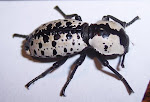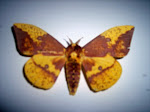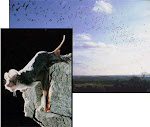Issue 8 - September 22, 2009 Imperial Moth
Good Morning to you neighbor! I’m sitting here with Mr. Folgers (the red one, not the fake green stuff), and we are patiently waiting for the sun to bust out in the east. I don’t think there will be much ‘busting’ this morning because the clouds that brought the rain last night are probably lingering around up there. Hope so, because it will cool things off and I, for one, prefer 74 degrees to 104.
It is officially autumn here in Paradise and the recent rains have made it just that more beautiful. Mystic Shores is pleasing to the eye at any time of the year but right now it has some special attraction. As the light grabs hold, I can see that there is a hint, just a hint mind you, of the seasonal change but it is masked by the green that follows any rain here in the Hill Country. Join me as I go out on the porch to take in the scene.
I can see six shades of green plants between my house and the lake. I see rose colored tuffs of grass and tiny little blue blossoms in the path. There are yellow flowers sprinkled everywhere, with wide swaths of them down by the water’s edge. The water itself takes on the color of the sky so it appears light grey right now, with darker streaks where the wind has stirred it up. It is a pretty picture and I just can’t help but grin when I see such beauty in nature. However, I’m a wildlife guy and I’m wondering where the meat is. Where is the beef? Certainly my fauna can hold its own with all this flashy flora!
I read somewhere that beauty is in the eye of the beholder. I think I get that concept. Since I can’t see the world from anyone’s perspective but my own, I’m going to write this issue of “Our Creatures” on what I believe is one of the most beautiful creatures we have here in Mystic Shores. Behold the Imperial Moth.
(Kingdom; Animalia, Phylum; Arthropoda, Class; Insecta, Order; Lepidoptera, Family; Saturniidae, Genus: Eacles, Species: E. imperialis)
The moth above is a male Imperial Moth and the picture is life size. (The wingspread of this fellow is over four inches!) I found him last month in our covered pavilion area near the entrance to Mystic Shores on the south side of 306. He was perched on the side of the mailboxes at 2pm in the afternoon.
This gorgeous creature is a member of the moth family that includes the giant silk moths. In this species, the females are larger than the males but their coloration is not quite as striking. The females have more of the ‘sulfur yellow’ and less of the ‘purple-brown’ coloration. I think that this color combination is fabulous, and I don’t know of anywhere else in the animal world where you find yellow and purple together like this. They don’t hide it either, because like all moths they open their wings when at rest. (Butterflies are different, in that they fold their wings back above their bodies when resting.) The color patterns vary quite a bit from moth to moth but, in general, the forewings have more of the purple color and there is more purple on the males. This particular Imperial Moth also exhibits other classic features of the moth family in its adult stage, such as its feathery antennae, the eye spots, and heavy body.
Humor me on this……. Squint at the picture above. Do you see the owl’s face? Do you think this might scare off a potential predator?
These insects are single brooded (one generation per year) and spend the winter in the ground as pupae. The adults emerge once a year and only have a lifespan of about a week. In fact, they don’t feed during this period and their mouthparts are reduced and non-functional. The adults emerge between April and October in our part of the country. They emerge before sunrise and mate after midnight the next day, if they are lucky enough to find a mate. One way nature has helped them to find one another in this rapid sequence is through the use of pheromones. These are chemicals emitted by the females that the males can detect up to a mile away. Think of that…… this little insect can detect a mate a whole mile away. (I can’t smell my wife’s perfume from a distance of three feet on a good day.) Anyway, once mated, the female lays her yellow eggs at dusk either singly or in small groups until she has laid approximately 200 eggs total.
The eggs are normally laid on the underside of the host plant leaves. Here in the Hill Country, the favored food is oak. After about two weeks, the eggs hatch and the caterpillars begin their solitary feeding.
Interestingly, there are two different color phases of the caterpillars. They can be either dark brown (and grow to look like a 4” spiny hot dog) or green (and look like a hairy, horned, green purple-people-eater). Regardless of their fierce and strange looks the caterpillars are harmless, and all go through five molts (called ‘instars’) before finishing this stage of metamorphosis. After they have completed their last molt they burrow into the ground and pupate over the winter. There is no cocoon.
They are fairly common throughout the eastern half of the United States and here in central Texas we are at the western edge of their distribution. You won’t find them in west Texas or the panhandle. For unknown reasons, they are becoming scarce in parts of New England.
The Imperial Moth is perhaps our only fauna that is featured as a character in a novel. Gene Stratton Porter’s “Girl Of The Limberlost” features Imperial Moths prominently in the plot. The girl, Elnora Comstock, chronicles the life cycle of the Imperial Moth and her growing discovery of nature is reflected in her childhood fascination with the beautiful creatures.
I can relate to that.
Clay
Click on these pictures to go directly to the article.
Followers
Blog Archive
About Me

- Clay Crum
- I'm always looking for suggestions (or photos) about other Mystic Shore wildlife. Do you know where a rattlesnake den is located? Do you have pictures of a mountain lion taken locally? Have you had interesting encounters with our wildlife? Share them with me by sending me an email or commenting on this blog.













